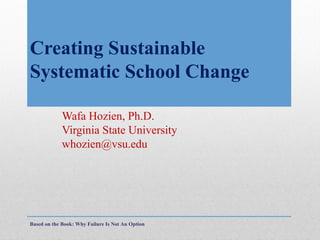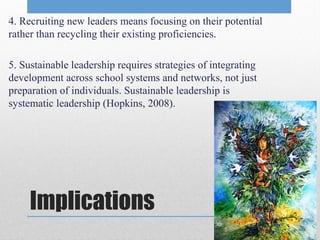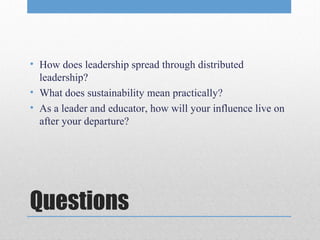Creating Sustainable School Change
- 1. Creating Sustainable Systematic School Change Wafa Hozien, Ph.D. Virginia State University whozien@vsu.edu Based on the Book: Why Failure Is Not An Option
- 2. Sixth Principle: Building Sustainable Leadership Capacity CHAPTER 10
- 3. Why Build Leadership Capacity? The Job Is Too Big To Do Alone • Sustaining high-achieving schools because failure is not an option for any student – is a big job • The principal’s job is too big and too complex to be done alone
- 4. • Shared leadership develops commitment and yields higher student achievement Shared Leadership
- 5. Defining Leadership: Five Key Responsibilities 1. Shaping a vision of academic success for all students 2. Creating a climate hospitable to education 3. Cultivating leadership in others 4. Improving instruction 5. Managing people, data and processes
- 6. Building Capacity via Institutionalizing Processes, Routines and Habit • The formation of habits includes three elements: 1. A cue 2. The routine 3. The reward
- 7. Sustainable Leadership (Hargreaves & Fink) • Focus on: 1. Leadership of learning 2. Distributed leadership 3. Leadership succession 4. Integrating leadership
- 8. Background of Sustainability • Implementation • Institutionalization • Maintainability
- 9. The Meaning of Sustainability Sustainable leadership is characterized by • Depth of learning and real achievement •Length of impact over the long haul •Breadth of influence •Justice in ensuring that leadership actions do no harm •Diversity that replaces standardization •Resourcefulness •Conservation
- 10. Discussion of Implications 1. The future of leadership must be embedded in the hearts and minds of the many and not rest on the shoulders of a heroic few. 2. Educational systems should see leadership as a vertical system over time. 3. The promise of sustainable success in education lies in creating cultures of distributed leadership throughout the school community, not in training and developing a tiny leadership elite.
- 11. 4. Recruiting new leaders means focusing on their potential rather than recycling their existing proficiencies. 5. Sustainable leadership requires strategies of integrating development across school systems and networks, not just preparation of individuals. Sustainable leadership is systematic leadership (Hopkins, 2008). Implications
- 12. Positive Interconnectedness of Sustainable Leadership Occurs in Several Ways: 1. In networks of accreditation and evaluation. 2. In networks of learning and improvement. 3. In area-based crossschool collaboration.
- 13. Ten Things That Are Sustainable About You 1. Refocus your curriculum, use of materials, and school design to include ecological sustainability as a core aspect of teaching and learning for all students. 2. Begin all discussions about achievement and how to raise it with conversation and reflection about the learning that underpins the achievement. 3. Insist that all school improvement plans contain leadership succession plans.
- 14. 4. Make it a condition of professional employment that every teacher and leader is part of a learning team 5. Write your own professional obituary. 6. Form a three-sided partnership with a lower-or-higherperforming district or school 7. Establish a collaborative of schools in your town or city, across district boundaries, to commit to community development initiatives Sustainable You
- 15. 8. Create a system where principals and leadership teams in successfully turned-around schools can take on a second school or third 9. Coach a teacher who looks like they have little capacity for leadership 10. Spend more time in schools as a way to develop genuine interest in, curiosity about and knowledge of what teachers and students are doing Sustainability
- 16. Education is the most powerful weapon which you can use to change the world. - Nelson Mandela
- 17. • How does leadership spread through distributed leadership? • What does sustainability mean practically? • As a leader and educator, how will your influence live on after your departure? Questions
- 18. • Blankstein, Alan M. (2004). Failure Is Not an Option: Six Principles That Advance Student Achievement in Highly Effective Schools. Thousand Oaks, Calif. : Corwin. References


















